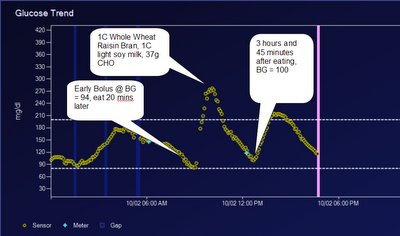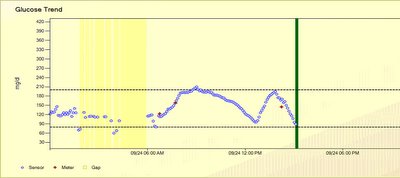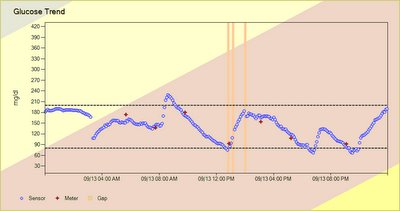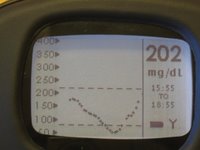Took the Dexcom to the gym today to run an interference test, confirming what Insulin Factor has observed: Dexcom does not like my polar heart rate monitor. After attaching my heart rate monitor strap, the Dexcom antenna icon went bye bye, and didn't return until after my workout. The previous day when I used the treadmill, there was no interference from that piece of equipment; I'm going to try it while I use the elliptical trainer next week. The exercise equipment in our gym is grouped closely toghether, and sometimes the built in heart rate monitors don't work properly due to their close proximity to eachother, so I'm wondering what effect if any, the ellipticals will have on the Dexcom. I probably won't wear the Dex during workouts when I use the heart rate monitor once I've profiled my trends during the type of exercise.
Dexcom Transmitter in the Shower
As I've been told, Dex transmitter does NOT like to get wet! My post shower readings shot up to over 400 after a shower. I don't want to use the shower covers to protect it, and I don't really mind if I don't know what my readings are for awhile after a shower. An hour after the shower with Dex still reading high, I decided to recalibrate (a simple matter of connecting a cable to your one-touch ultra), confirming the data sucessfully transfers, and then waiting until the Dexcom data comes back into agreement with your meter an hour or so after recalibration. No big deal!
Dexcom STS Only Works With The Older OneTouch Ultra Meter
Not too much of a problem for me, though I do miss my UltraSmart® meter. At first I thought that you could just use the OneTouch® Ultra® for calibration and then the UltraSmart the rest of the day; I was informed that Dexcom, however has to
learn each meter that it connects to, and that it uses as much data as you want to give it in it's algorithm to get good agreement between the Dexcom and the meter. Oh well, I'm becoming addicted to the trend data that the Dexcom gives me, and will have to do without the single point analysis that I get from the UltraSmart until Dexcom is able to work with Lifescan to get the download protocol for the UltraSmart, and the new meters, the
OneTouch® Ultra® 2, and the
OneTouch® Ultra Mini ™.









